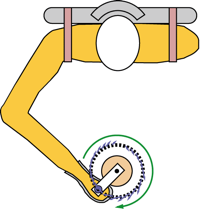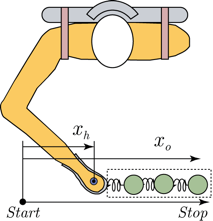Modeling of Human-Like Reaching Movements
Modeling of human-like reaching movements. Natural human movements are graceful and beautiful. The knowledge of basic principles of human movements can form a foundation for motion planning and control of robotic systems. Invariant features of the human arm reaching movements in the free space have been established and several optimization models quantifying the movements have been proposed. It is known that human arm trajectories in the free space are characterized by a slightly curved hand path and a bell-shaped hand velocity profile. However, it is not known if these invariant features are preserved when the human arm is embedded in a dynamic environment. It is also not known what optimality criteria could capture the dynamically constrained movements.
Fig.1. Human movements in dynamic environments (left and middle), and non-trivial experimental hand velocity patterns in the manipulation of flexible objects (right).
To address these questions, we analyzed human movements in the manipulation of virtual flexible objects (Fig. 1) by using a haptic interface. In the experiments, human subjects were requested to produce rest-to-rest reaching movements with suppression of residual vibrations. It was found that the hand velocity profile in this motor task can have multiple phases, and the minimum effort criterion allows for capturing this feature reasonably well. We also analyzed geometrically constrained movements in virtual environments, using different constraint curves, and found that extremes of the velocity correlate with extremes of the constraint curvature. It has been shown that the minimum effort criterion can also be used to capture this feature of the constrained movements. In addition to experiments with the haptic interface, we analyzed constrained reaching movements, using a crank-type manipulandum, and found that the minimum effort criterion, defined at the muscle level, also allows for predicting the muscle activation patterns.
More light would be shed on the nature of natural human movements by extending the class of dynamic environments to cover underactuated, nonholonomic, and non-minimum phase systems. Modern technology, such as virtual reality and haptic interfaces, allows for the creation of really interesting movement scenarios. Benefits of studying of human movements in dynamic environments would be twofold. On the theoretical side, we would clarify the formation of motion patterns and address the generation of human-like movements for robotic systems by using reliable computational tools. On the application side, this study would be well connected to robotic rehabilitation.


